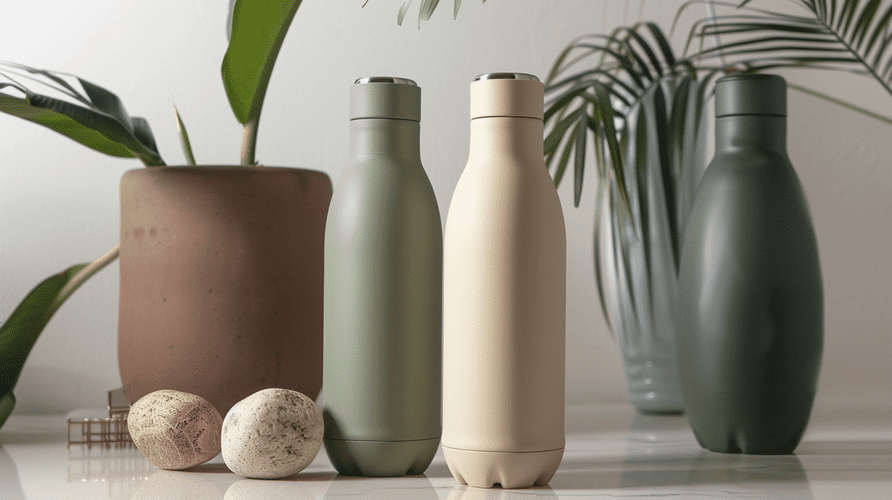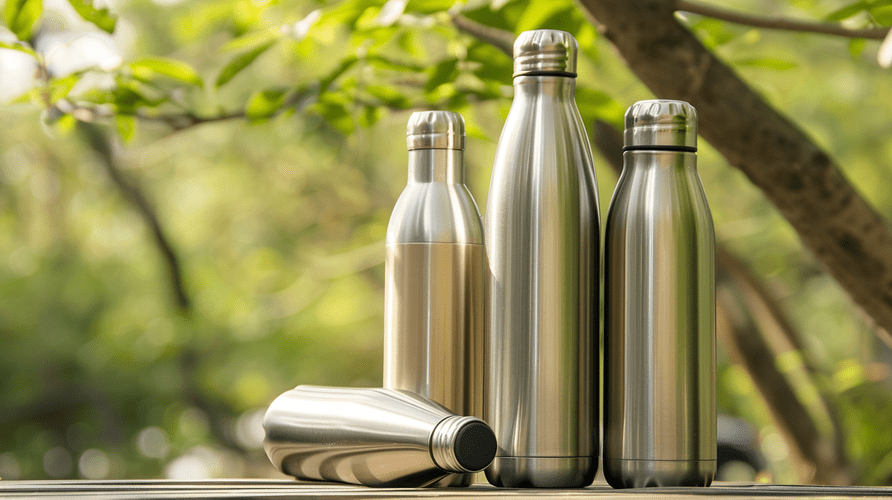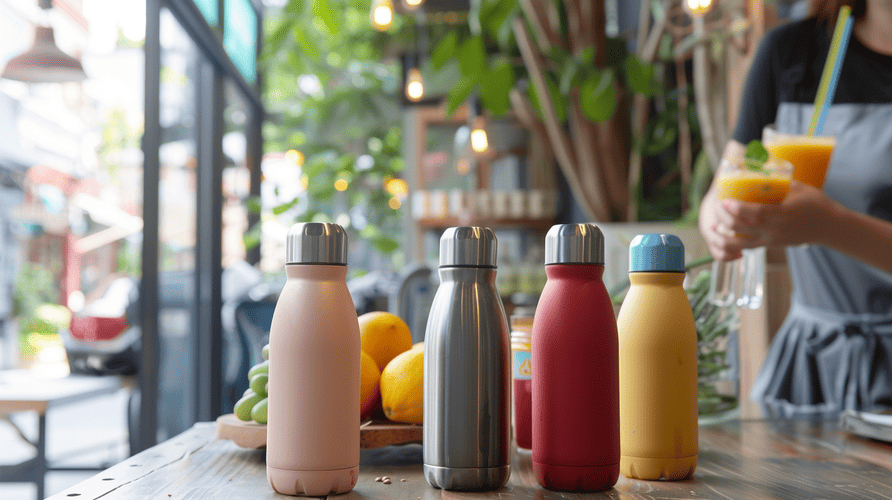Dirty bottle, bad taste? Germs can build up, affecting your health. Learn simple steps for a sparkling clean bottle.
To clean your water bottle effectively, use dish soap and hot water for daily washes. For a deeper clean, try vinegar or baking soda. Regular cleaning keeps it fresh and safe.

Keeping your water bottle clean is important for your health and the taste of your drinks. Many people wonder about the best methods. As a manufacturer at Icobottle, I see how bottle design impacts cleaning every day. My clients, like Mark Shenng from Canada, are always interested in this because it affects their customers. Let's explore more.
What is the best way to clean the inside of a bottle?
Can't reach inside easily? Residue builds up, causing bad smells. Use the right tools and methods for a fresh bottle.
The best way to clean inside a bottle is with a bottle brush1 and hot, soapy water. For tough grime, a soak with vinegar or baking soda solution works well.

Cleaning the inside of a water bottle properly is a big concern for end-users. This is something my client, Mark, often brings up. He's a company owner in Canada and procures stainless steel water bottles to rebrand and sell. He knows that if his customers find it hard to clean the bottles he sells, they won't buy again. So, what makes a bottle interior easy to clean?
First, the material matters a lot. Stainless steel, especially grades like 304 or 316 that we use at Icobottle, is great. It has a very smooth surface. Germs find it hard to stick to smooth surfaces. This makes cleaning much easier. Some plastics, on the other hand, can get scratched over time. Germs can hide in those tiny scratches, making the bottle harder to truly clean.
Second, the opening of the bottle is key.
- Wide Mouth Bottles: These are generally the easiest to clean. You can easily get a brush inside. More importantly, you can see the inside clearly to check if it's truly clean. I always recommend wide-mouth designs to Mark for this reason.
- Narrow Mouth Bottles: These can be tricky. You definitely need a good bottle brush, one that’s long and flexible enough. Sometimes, even with a brush, it's hard to reach every single spot, especially the bottom corners.
For Mark's B2B business, offering bottles that are easy to clean is a significant selling point. He needs to assure his customers that the bottles are hygienic and simple to maintain. We often discuss design features that help with this. For example, rounded interior bases are much better than sharp corners. Residue is less likely to get trapped in a smooth, curved base. As a B2B buyer, Mark looks for these specific details because they reduce complaints from his customers later on. He's sensitive to quality but also needs competitive pricing, so these practical features add value.
Here's a simple comparison for interior cleaning that I often share with clients:
| Feature | Impact on Cleaning | Recommendation for B2B Buyers (like Mark) |
|---|---|---|
| Material | Smooth stainless steel is easiest. Plastic can scratch. | Always choose high-quality 304 or 316 stainless steel. |
| Mouth Width | Wider is much easier for access and visibility. | Offer a range, but strongly highlight wide-mouth benefits for ease of cleaning. |
| Interior Base | Rounded corners prevent residue buildup. | Prefer designs that avoid sharp internal angles and crevices. |
Mark also asks about the best cleaning solutions2. For regular, daily cleaning, warm water and a little dish soap are usually enough. For a deeper clean, perhaps once a week or if the bottle has been left with liquid in it, a mixture of baking soda and water, or white vinegar and water, can be used. I tell him to advise his customers to let it soak for a bit – maybe 30 minutes or even a few hours for stubborn grime – and then scrub thoroughly with a bottle brush. Always rinse well with fresh water afterwards. This advice is simple, but for Mark's customers, it means they can keep their bottles fresh and hygienic for a long time. This reflects well on his brand in Canada.
What is the easiest water bottle to clean?
Hate complicated cleaning routines? Some bottles are a nightmare, and you might just stop using them. Choose designs that make cleaning quick and simple.
The easiest water bottle to clean usually has a wide mouth and a simple lid with few parts. Bottles made of stainless steel are also easier as they resist residue buildup.

This question, "What is the easiest water bottle to clean?", is crucial from a product selection standpoint for B2B buyers like Mark. It directly influences the end-user satisfaction. If the final customer finds the bottle hard to clean, they will associate this frustration with Mark's brand, not just the bottle itself. As his supplier, we at Icobottle pay close attention to this because we want Mark's business to succeed. His success is our success.
So, what specific features make a bottle "easy to clean"?
-
Design Simplicity: This is paramount. Fewer parts mean fewer places for dirt, bacteria, or mold to hide.
- Lids: This is often the most complex part. Lids with many small components, intricate seals, or built-in straws can be very difficult to clean thoroughly. Each part needs to be disassembled and cleaned individually. Mark always prefers simpler lid designs for this reason. When we develop new bottle design3s, we often review lid mechanisms specifically to ensure they are easy for an average person to take apart and put back together without tools or frustration.
- Bottle Body: As I mentioned before, a wide mouth is a huge advantage. Beyond that, straight or gently curved walls are easier to scrub than bottles with intricate shapes or interior crevices that a brush might miss.
-
Material Quality and Finish:
- Stainless Steel: High-quality stainless steel (like the 304 or 316 grades we specialize in) is non-porous. This means it doesn't absorb flavors or odors, and it resists staining. This makes it inherently easier to get clean and keep clean compared to some other materials. A smooth interior finish, often achieved through electropolishing, further enhances this.
- Glass: Glass is also very easy to clean for the same reasons (non-porous) but comes with the obvious drawback of being fragile, which isn't ideal for all uses or for Mark's typical customer base.
- Plastic: Some plastics can stain or retain odors, especially if they are lower quality or become scratched. While BPA-free is a standard requirement now, the type of plastic also affects its long-term cleanability and durability.
For Mark, who purchases stainless steel water bottles from us in China and then distributes them under his own brand in Canada, the "easy to clean" factor is a key selling proposition. He needs products that require minimal effort from his customers to maintain. This is why he is very particular about the samples we send him. I know he personally checks how easy it is to take apart the lid, if all parts of the bottle are accessible with a standard bottle brush, and how it feels after a few washes.
Consider these points when you are evaluating a water bottle's ease of cleaning, especially if you are a procurement officer or business owner:
| Aspect | Easy to Clean Features | Difficult to Clean Features | Impact for B2B Importer (like Mark) |
|---|---|---|---|
| Mouth | Wide enough for hand/brush access. | Narrow, difficult to reach inside. | Higher user satisfaction, fewer returns. |
| Lid | Simple construction, few parts, easy to disassemble. | Complex, many small parts, hard to take apart, integrated straws that are hard to dry. | Reduced complaints, positive brand image. |
| Material | Smooth, non-porous 304/316 stainless steel, glass. | Some plastics, materials that stain or hold odors easily, rough finishes. | Perception of quality and hygiene. |
| Shape | Straight or gently curved sides, rounded internal base. | Intricate shapes, sharp internal corners, nooks & crannies. | Affects likelihood of repeat purchases. |
I always advise Mark to think about the entire lifecycle of the bottle from the end-user's perspective. A bottle that’s a breeze to clean is a bottle that gets used daily and is well-loved. This creates positive associations with his brand. It’s a seemingly small detail, but it has a big impact on customer loyalty and word-of-mouth referrals.
How to remove black spots in a water bottle?
See black spots inside your bottle? This could be mold, which is unhealthy. Learn how to remove them effectively and prevent them from coming back.
To remove black spots, likely mold, use a strong cleaning solution like diluted white vinegar or hydrogen peroxide. Specialized bottle cleaning tablets also work. Scrub well and rinse thoroughly. Ensure the bottle dries completely.

Finding black spots4 in a water bottle is alarming for any user. For Mark, as someone who sells these bottles, it's a serious quality concern that could damage his brand's reputation. These spots are usually mold or mildew, which thrive in damp, enclosed environments. This issue directly relates to the bottle's material, its design, and how well it can be cleaned and, crucially, dried. Mark understands sales but lacks deep technical expertise, so he relies on us for guidance on preventing such issues.
Here’s how I advise Mark on this issue from a product and supplier perspective, focusing on prevention and reliable solutions:
-
Material Choice is Key to Prevention:
- Stainless Steel Advantage: High-grade stainless steel (304 or 316, which Icobottle uses) is highly resistant to corrosion and, importantly, is less prone to microbial growth compared to some plastics. A very smooth interior finish, which we achieve through processes like electropolishing, also means there are fewer microscopic places for mold spores to cling to and grow. This is a point Mark now emphasizes to his customers as a benefit of the bottles he sources.
- Potential Issues with Other Materials: Some lower-quality metals or certain plastics, especially if they develop scratches or have rougher surfaces, can harbor moisture and microbes more easily, creating an environment where mold can take hold.
-
Design for Dryness (Not Just Cleaning):
- Lid Design: Trapped moisture in lid components is a common culprit for mold growth5. Lids with complex nooks and crannies, or seals that don't allow for complete air circulation and drying, can become breeding grounds. This is why Mark is so thorough when he inspects lid designs. Simple, easy-to-disassemble lids allow all individual parts to air dry completely, which is vital.
- Bottle Shape and Draining: Bottles that can't be easily inverted to drain fully or have areas where water might pool (like an overly concave base internally) can also lead to problems.
-
Cleaning and Prevention Advice for End-Users (which Mark can pass on to his customers):
- Regular Cleaning: This is the first and most important line of defense. Daily rinsing and weekly thorough cleaning.
- Thorough Drying: This is absolutely critical. After washing, bottles and all lid parts should be left to air dry completely, preferably disassembled. I once shared a personal story with Mark: I accidentally left one of my own sample bottles sealed with a bit of water inside for about a week during a business trip. When I opened it, the smell was terrible, and I could see the beginnings of small spots. It was a potent reminder of how quickly mold can start if a bottle isn't dried properly. He found this relatable.
- Removing Existing Spots: If spots do appear, here's a reliable method:
- Soak: Create a solution of one part white vinegar to four parts warm water. Alternatively, a few drops of 3% hydrogen peroxide mixed with water can be used. Fill the bottle and let it soak for several hours, or even overnight for stubborn spots.
- Scrub: Use a good quality bottle brush to scrub the spots vigorously. Pay attention to all interior surfaces.
- Rinse: Rinse thoroughly with hot water multiple times to remove all traces of the cleaning solution and dislodged particles.
- Dry: As always, dry completely and leave it open to air.
Here’s what B2B buyers like Mark should specifically look for during procurement to minimize issues with black spots for their customers:
| Feature | Importance for Preventing Mold | Icobottle's Approach for Quality Assurance |
|---|---|---|
| Interior Finish | A smooth, non-porous surface like electropolished stainless steel inhibits microbial adhesion and makes cleaning effective. | We ensure a high-quality, smooth interior finish on our 304/316 stainless steel bottles. |
| Lid Disassembly & Material | All parts must be easily separable for thorough cleaning and complete drying. Seals should be made of quality, mold-resistant material. | We prioritize lid designs that are easy to take apart and reassemble, using quality silicone for seals. |
| Material Quality & Certification | High-grade, certified materials are less susceptible to degradation or pitting that could harbor microbes. | We conduct strict quality control on raw materials and provide material test reports to clients like Mark, addressing his concern about potential certificate fraud from previous suppliers. |
| Clear User Instructions | Educating end-users on proper cleaning and, especially, drying techniques is crucial. | We provide guidance that clients like Mark can adapt and share with their customers, adding value to his brand. |
Mark's past experiences with inefficient communication and occasional certificate fraud from other suppliers make him very cautious. He appreciates our transparency regarding materials and our willingness to discuss technical aspects in simple terms. Ensuring the fundamental quality of the bottle materials and design is the first and most effective step in preventing problems like mold growth. It makes the bottle easier to clean and maintain for the end-user, which ultimately protects his brand reputation in the competitive Canadian market.
Conclusion
Regular, proper cleaning keeps your water bottle fresh, safe, and ready for use. Choose designs and materials that make cleaning easy for long-lasting satisfaction and health.
-
Explore this link to find the best bottle brushes that can make cleaning your water bottles easier and more effective. ↩
-
Learn about effective cleaning solutions that can help maintain the hygiene of your water bottles, keeping them fresh and safe to use. ↩
-
Learn about the most effective bottle designs that simplify cleaning, which can significantly impact user experience and brand perception. ↩
-
Understanding the causes and solutions for black spots can help you maintain a clean and safe water bottle. ↩
-
Preventing mold growth is essential for health and safety; explore effective strategies to keep your bottle clean. ↩

